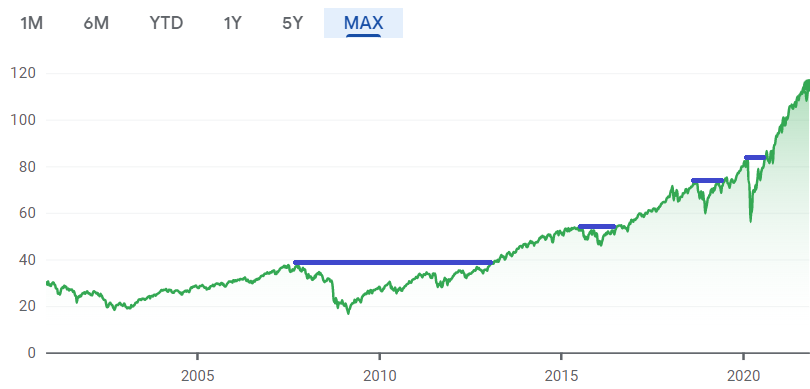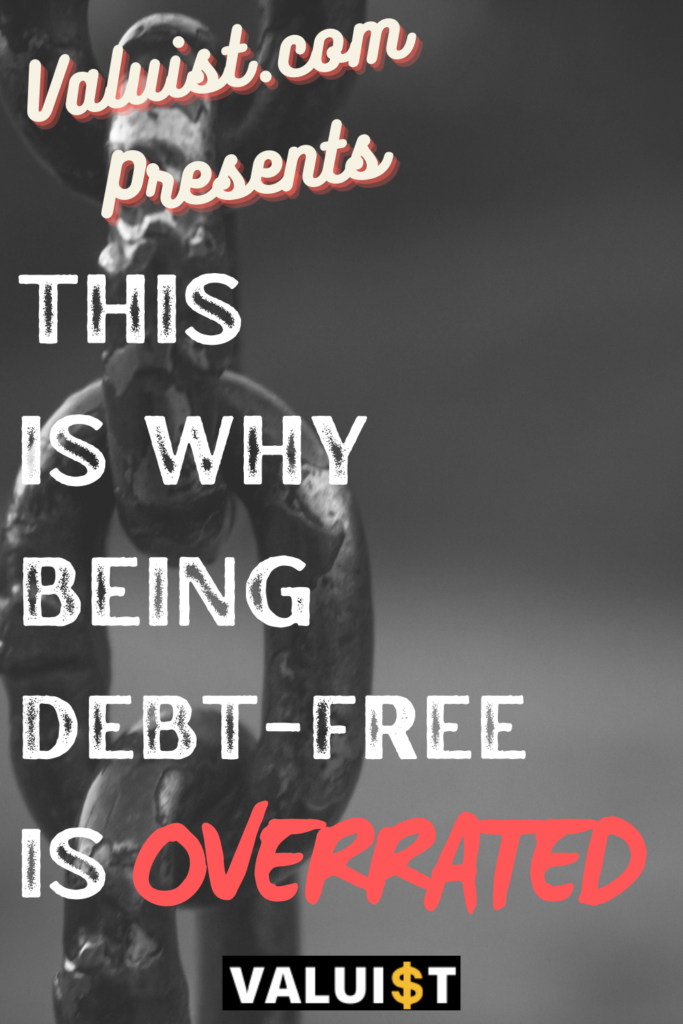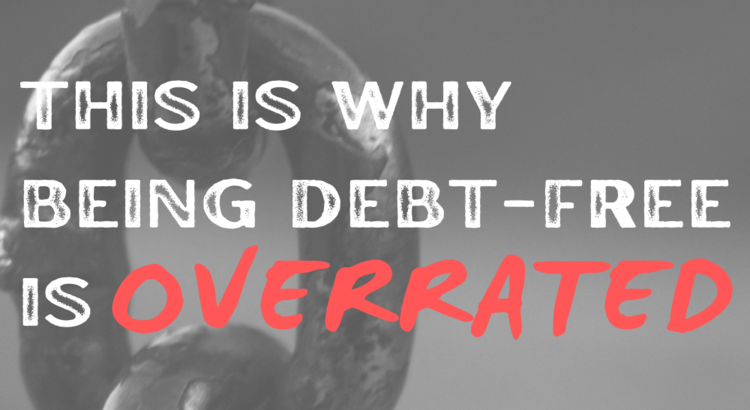There’s a lot of talk, mostly in online personal finance forums, about the benefits of being completely debt-free. Not just somewhat debt-free, 100% debt-free, as in only buying cars with cash-on-hand, not using credit cards and avoiding mortgages. Though I can understand the attraction to being totally debt-free and even once wrote about why you should never borrow or lend money, being completely debt-free is a money mistake that you cannot afford to make. Being completely debt-free is psychologically liberating but ultimately it’s a decision that reduces your buying power and consequently, your long-term quality of life. Especially given that you can leverage low-cost debt to multiply your net-worth, while the practice of avoiding all debt exposes you to opportunity costs and inflation.
Good debt versus bad debt
Good debt is cyclical debt, paid when it’s due each and every month, like credit card or mortgage debt. Good debt rewards you for your timely payments and helps you establish excellent credit. Subsequently, it enables you to secure the best interest rates when you want to finance a purchase.
Related: Top 5 Ways to Use Credit Card Loyalty Rewards (and What to Avoid)
Bad debt is debt that is not satisfied-in-full when it’s due. Bad debt forces you to pay high interest rates when you need to borrow, and consequently, it reduces your buying power and your quality of life. Bad debt can lead to strangers calling at all hours, your wages to be garnished and your bank accounts getting levied.
The math behind opportunity cost
So obviously we want to have good debt and avoid bad debt. But what’s so wrong with owning all of your assets outright and never owing anybody? I’m attracted to the idea but the problem is that being 100% debt-free inevitably causes you to miss out on investments that can multiply your net worth, like real estate. Buying everything in cash also means driving outdated vehicles. It’s not worth it to avoid a little bit of interest just to adhere to the 1/10th rule, especially if you’re driving something that isn’t as safe, reliable and fuel efficient as a modern vehicle.
Further, because of inflation, using a lot of cash today is actually more expensive than spreading payments out over several years. That’s because over time, the value of money decreases but the terms of a fixed-rate loan never change. In the United States, the Federal Reserve adjusts interest rates to try to attain a 2% rate of inflation, to keep the cost of goods increasing gradually over time.
The Federal Open Market Committee (FOMC) judges that inflation of 2 percent over the longer run, as measured by the annual change in the price index for personal consumption expenditures, is most consistent with the Federal Reserve’s mandate for maximum employment and price stability.
The Fed
Maintaining a completely debt-free lifestyle means that you probably won’t live in a modern home or drive a modern car but that in itself doesn’t preclude you from being happy.
Related: Does Money Buy Happiness?
Example #1 – Buying a car with cash versus financing the purpose and investing instead
Car Loan Calculation
| Total* Cost of Loan | $30,000 |
| Sales Tax | 8.7% ($2,632) |
| Dealer Fees | $250 |
| APR | 2.2% |
| Loan Length | 60 Months |
| TOTAL LOAN | $32,882 |
| TOTAL INTEREST | $1,872 |
|---|
*Cost of loan includes down-payment or trade-in value
From the example above, if the car I want costs $40,000 and I trade-in my old vehicle for $10,000, I would have a $30,000 initial loan. After adding average dealership fees of $250 and a 8.7% sales tax rate ($2,632, and I’m using this abnormally high sales tax rate because I recently discovered that that’s the average rate here in Washington), my total loan is for $32,882.
At 2.2% APR over 60 months, my total interest payment comes out to: $1,872.
That’s only $31.20 a month paid in interest to drive a very nice, new car, while covering only one quarter of the cost up front. That’s seem great at face value but if you check the math, even putting down $10,000 proves to be a mistake as I will soon demonstrate.
What if I put down $0.00 on the same $40,000 vehicle with the same terms? It turns out that I would pay an additional $10.32 in interest for a total of $41.52 each month, and I would be wishing that I had held on to that $10,000.
What if I don’t have the best credit and can only secure an interest rate of 4%? In that case, and if I can still somehow secure this loan with $0.00 down, I would pay $4,594 over the term of the loan, or $76.57 per month in interest. That figure is getting higher, however, I can still easily offset that cost over 5 years using just the $10,000 that I had in the first example.
The Average 5 Year Return From A Total Stock Market Index Fund
| Investment | VTSAX (Total US Stocks) |
| Total Investment | $10,000 |
| Investment Term | 5 Years |
| Average 5-Year Return | 16.87% |
| Expense Ratio | 0.04% |
| Long-Term Tax Rate | 15% |
| Long-Term Return | $21,766 |
| Return After Tax and Fees | $20,001 |
|---|
Investing in a broadly diversified index fund is the only free lunch in investing. So, if I choose to invest $10,000 into a total US stock market fund like VTSAX, using the average 5-year return and the long-term capital gains rate, my brokerage account would grow to a healthy $20,001 – $10,001 would be my total return after accounting for taxes and fees. That means that I become $8,129 richer by investing the $10K instead of using that money as a down payment on a loan at 2.2% APR. That’s not even accounting for inflation (i.e. repaying the loan with currency that loses value over time). In fact, unless I have to pay exorbitant rates in interest, in which case I should probably consider alternative modes of transportation, it’s unlikely that putting more money down in deposit is ever the right decision.
But you might be saying that the stock market is inherently risky and I could lose that $10K too. Well, it’s true that the stock market comes with risk; I could end up paying more in interest, because I reduced my down payment, and if the stock market crashes at anytime within the next five years it could seem like I made a huge error in judgement. Really though, that sounds a lot worse than it is. Investors don’t lock in gains or losses in the stock market until they decide to sell stock and in recent history, major stock market crashes and even minor corrections have surpassed previous highs in less than 5 years.
Not that historical returns are indicative of future returns but the point is that if you prioritize risk-adjusted investing over avoiding interest, you will likely come out way ahead over a lifetime of car buying. Not surprisingly, this is true for home-buying too and it’s why that you should not rapidly pay off your mortgage.

Example #2 – Avoiding using credit cards can be costly
As I wrote about in, 5 Controversial Personal Finance Rules That I Live By, I use credit cards for everything. Besides coming with some pretty nice benefits such as:
- Trip cancellation insurance
- Rental collision damage waiver
- No foreign transaction fees
- Early-access tickets and priority seating
- Road-side assistance
- Concierge services, and
- Annual travel credits
using and paying off credit cards naturally helps you establish good credit over time. With good credit you can get the best interest rates and you can use the power of leverage to increase your quality of life without added risk. Related: Top 5 Ways to Use Credit Card Loyalty Rewards (and What to Avoid)
If the numerous benefits and credit-building power weren’t enough, most credit cards also give you cash back on every purchase, or loyalty rewards points that end up being worth thousands of dollars.
___________________
So, don’t be debt free, be bad-debt-free and use good debt to increase your net worth and quality of life. To track and increase your net worth take a look at this awesome free tool we developed at Valuist.com.


